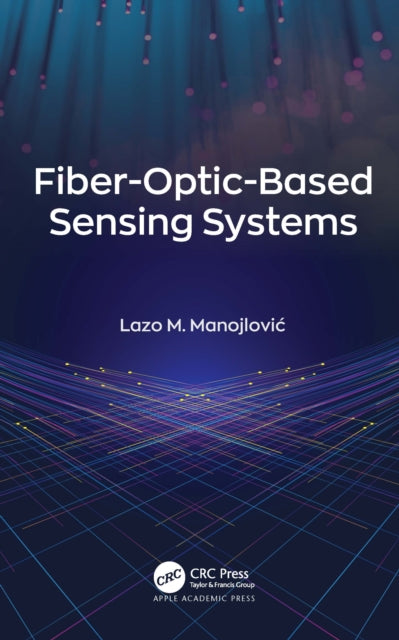Lazo M. Manojlovic
Fiber-Optic-Based Sensing Systems
Fiber-Optic-Based Sensing Systems
YOU SAVE £6.67
- Condition: Brand new
- UK Delivery times: Usually arrives within 2 - 3 working days
- UK Shipping: Fee starts at £2.39. Subject to product weight & dimension
Bulk ordering. Want 15 or more copies? Get a personalised quote and bigger discounts. Learn more about bulk orders.
Couldn't load pickup availability
- More about Fiber-Optic-Based Sensing Systems
Fiber-optic sensors are unique due to their ability to detect and measure various physical properties. They use optical fibers to transmit and receive signals, making them highly sensitive and reliable. State-of-the-art technology in optical fiber sensors includes single-mode and multimode fibers, fiber Bragg gratings, and optical time-domain reflectometers. Different detection techniques, such as fiber optic interferometry, optical coherence tomography, and Raman spectroscopy, are used to analyze the transmitted signals. Distributed fiber-optic sensing systems are also discussed, which involve the use of multiple fiber sensors to monitor large areas or objects.
Format: Hardback
Length: 328 pages
Publication date: 02 June 2022
Publisher: Apple Academic Press Inc.
Fiber optics sensors are a unique and cutting-edge technology that has revolutionized the field of sensing. These sensors utilize optical fibers to transmit and receive signals, making them highly sensitive and versatile. In this article, we will explore the state-of-the-art technology in optical fiber sensors, discuss a variety of fiber-optic topologies, and consider different detection techniques. We will also give special attention to distributed fiber-optic sensing systems, which have become increasingly popular in recent years.
Optical fiber sensors are characterized by their high sensitivity and versatility. They can be used to detect a wide range of physical and chemical properties, including temperature, pressure, strain, and chemical composition. One of the key advantages of optical fiber sensors is their ability to transmit signals over long distances without loss of signal quality. Optical fibers are highly flexible and can be woven into complex structures, allowing them to be deployed in a variety of applications.
There are several different fiber-optic topologies that can be used for sensing applications. One of the most common is the single-mode fiber topology, which is used for long-distance sensing applications. Single-mode fiber has a narrow core diameter, which allows for high-speed data transmission. Another popular topology is the multimode fiber topology, which is used for short-distance sensing applications. Multimode fiber has a larger core diameter, which allows for more flexibility and easier installation.
Detection techniques for optical fiber sensors can be divided into two categories: direct detection and indirect detection. Direct detection involves using optical fibers to directly measure the properties of the material being sensed. This can be done by using optical fibers to measure the intensity of light or the wavelength of light. Indirect detection involves using optical fibers to measure the effects of the material being sensed on the light. This can be done by using optical fibers to measure the refractive index or the attenuation of light.
Distributed fiber-optic sensing systems are a type of optical fiber sensor that is used to measure the properties of a material over a large area. These systems consist of a network of optical fibers that are distributed throughout the area being sensed. The sensors in these systems can be used to measure a wide range of properties, including temperature, pressure, strain, and chemical composition.
One of the key advantages of distributed fiber-optic sensing systems is their ability to measure the properties of a material over a large area. This allows for the monitoring of large structures, such as buildings, bridges, and pipelines, without the need for invasive sensors. Distributed fiber-optic sensing systems are also highly flexible and can be easily adapted to a variety of applications.
In conclusion, fiber optics sensors are a unique and cutting-edge technology that has revolutionized the field of sensing. These sensors utilize optical fibers to transmit and receive signals, making them highly sensitive and versatile. In this article, we have explored the state-of-the-art technology in optical fiber sensors, discussed a variety of fiber-optic topologies, and considered different detection techniques. We have also given special attention to distributed fiber-optic sensing systems, which have become increasingly popular in recent years. As the technology continues to evolve, we can expect to see even more innovative and exciting applications of optical fiber sensors in a wide range of industries.
Weight: 790g
Dimension: 229 x 152 (mm)
ISBN-13: 9781774637241
This item can be found in:
UK and International shipping information
UK and International shipping information
UK Delivery and returns information:
- Delivery within 2 - 3 days when ordering in the UK.
- Shipping fee for UK customers from £2.39. Fully tracked shipping service available.
- Returns policy: Return within 30 days of receipt for full refund.
International deliveries:
Shulph Ink now ships to Australia, Belgium, Canada, France, Germany, Ireland, Italy, India, Luxembourg Saudi Arabia, Singapore, Spain, Netherlands, New Zealand, United Arab Emirates, United States of America.
- Delivery times: within 5 - 10 days for international orders.
- Shipping fee: charges vary for overseas orders. Only tracked services are available for most international orders. Some countries have untracked shipping options.
- Customs charges: If ordering to addresses outside the United Kingdom, you may or may not incur additional customs and duties fees during local delivery.


